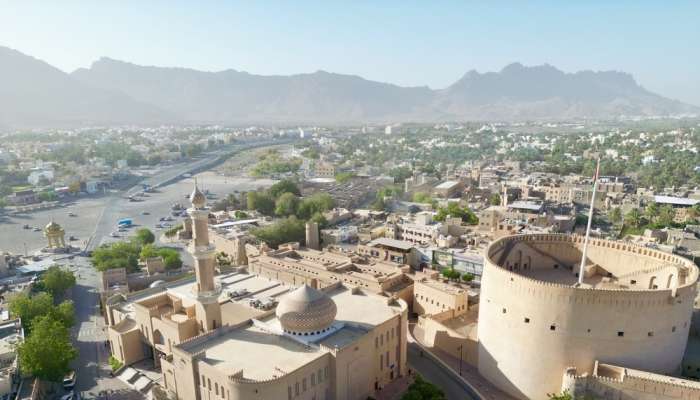
Nizwa— The Wilayat of Nizwa in the Governorate of A’Dakhiliyah stands as one of Oman's most prominent cultural and touristic destinations, renowned for its rich historical legacy and archaeological landmarks that chronicle significant chapters of the nation's past. Its distinctive architectural and heritage sites beautifully encapsulate Oman's authentic cultural identity.
The iconic Nizwa Fort dominates the historical landscape as a masterpiece of traditional Omani architecture and engineering. Adjacent to the fort, the vibrant Nizwa Souq (market) showcases exceptional local craftsmanship, from intricately forged daggers and handcrafted silverware to traditional markets selling livestock, fresh produce, and artisanal goods.
Falaj Daris, recognized on UNESCO's World Heritage list as one of Oman's largest aflaj irrigation systems, represents another jewel in Nizwa's heritage crown. This ancient water network sustains extensive agricultural lands while demonstrating centuries-old Omani ingenuity in sustainable water management. The recent development of a public garden within the falaj has further enhanced its ecological and touristic value.
Nizwa's strategic geographical location, combined with its diverse topography of wadis (valleys), mountains, and verdant oases, has established it as a prime destination for cultural and eco-tourism. These natural assets, along with progressive development initiatives, have positioned the Wilayat of Nizwa as an attractive investment hub for tourism and infrastructure projects.
Nizwa has achieved remarkable progress in sustainable development through
Strategic initiatives have been launched in Nizwa in a bid to achieve remarkable progress in sustainable development. These initiatives have further enhanced urban infrastructure and quality of life.
Significant development projects currently underway include A’Dakhiliyah Square launched earlier this year, an RO 7 million Integrated Public Transport Station, and restoration works in Haray Al Aqr where wall rehabilitation stands 65% complete with pathway paving 20% finished. The Public Garden Project has reached 40% completion, collectively aiming to elevate Nizwa's status as Oman's premier cultural-tourism destination while creating new economic opportunities.
Harat Al Aqr (an old neighborhood renovated by the locals) has transformed into a flagship example of youth empowerment, hosting 78 entrepreneurial ventures that have generated over 300 jobs for young Omanis. This revitalization has turned the historical quarter into a dynamic center for innovation and traditional crafts, featuring heritage cafes, artisanal shops, private museums, restored guesthouses, and classic car exhibitions. The area's cultural renaissance has dramatically increased property values from RO 10 to RO 1,500 per square meter and now attracts over 20 official delegations annually.
Sheikh Saleh Thiyab Al Rubaie, Wali of Nizwa, emphasized to Oman News Agency (ONA) that developmental projects are strategically designed to strengthen local economies while preserving cultural heritage. He noted Nizwa's unique historical assets perfectly position it to benefit from sustainable tourism and knowledge-based economic models.
The Wali highlighted how historical neighborhood restoration forms a cornerstone of Nizwa's economic strategy, serving the dual purpose of safeguarding cultural identity through architectural conservation while creating employment via tourism and SME development.
Nizwa Industrial City, under the Public Establishment for Industrial Estates (Madayn), represents another facet of Nizwa’s growth with 186 operational projects across 7.2 million square meters of developed area, attracting RO 504 million in cumulative investments and generating 6,100 jobs with a 45% Omanization rate.
Eng. Ishaq Ibrahim Al Kharousi, Acting Director General, revealed Madayn's upcoming RO 1.2 million Entrepreneurial Complex and ongoing studies for an integrated residential zone within the industrial city.
On her turn, Ahlam Hamad Al Qasabi, Director of Heritage and Tourism, outlined the ministry's comprehensive SME support programs including streamlined licensing procedures, specialized training initiatives, and incentive packages for heritage hospitality ventures.
She noted how the conversion of historical homes into heritage inns perfectly illustrates the purple economy approach, citing 600,000 visitors to Harat Al Aqr in the first quarter of 2023 as evidence of this model's success in merging cultural preservation with economic viability. The ministry continues to prioritize fortress restorations and historical documentation to enhance Oman's sustainable tourism offerings while safeguarding intangible cultural heritage.
This comprehensive development approach positions Nizwa as a model for balanced sustainable growth, where cultural heritage preservation and modern economic development progress hand in hand, creating new opportunities while maintaining the unique identity.
—— Ends/AH